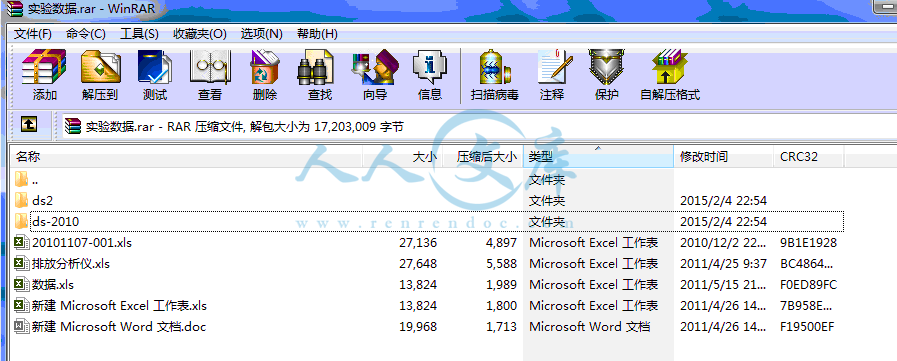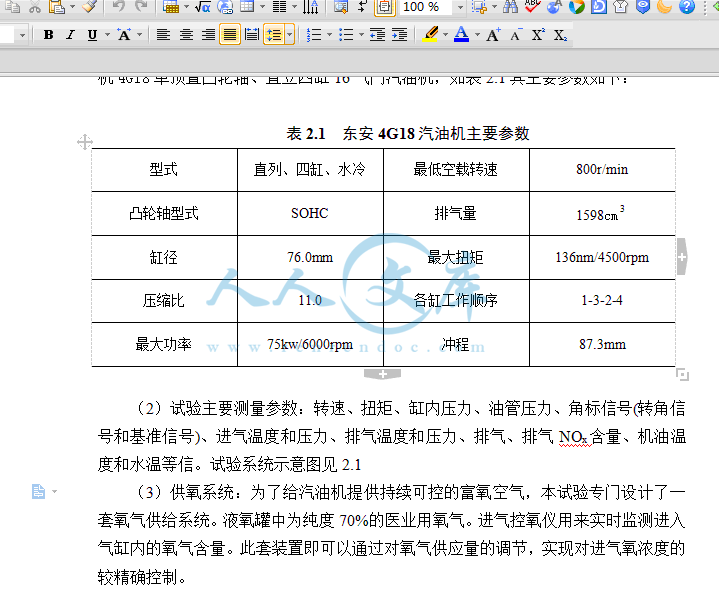汽油机的富氧燃烧试验研究
33页 18000字数+说明书+实验数据【详情如下】
任务书表格.doc
优秀设计.doc
实验数据.rar
封皮.doc
开题报告表格.doc
成绩评定表.doc
指导教师评分表.doc
汽油机的富氧燃烧试验研究论文.doc
答辩评分表.doc
评阅人评分表.doc
题目审定表.doc





摘 要
随着我国社会主义现代化建设事业的迅速发展和推进可持续发展战略的需要,对于社会上应用广泛,在国民经济建设和国防建设中具有十分重要作用的动力机械-内燃机,也提出了进一步提高性能,减少能源消耗和降低对环境的污染要求,而内燃机燃烧性能的好坏是直接影响内燃机的能耗性能和排放的重要因素。近年来,我国广大内燃机工业的科技工作者通过大量的研究,试验工作取得了许多科技成果使我国国产内燃机的燃烧性能得到了很大的改善和提高。但是,以往对内燃机燃烧的研究大多集中在内燃机工质的形成燃烧室,缸内气流运动及其三者之间的相互匹配等方面对于内燃机进气质量方面的研究则较少见。
在汽油机上应用进气富氧技术不但可以显著降低污染物的排放,而且还能够提高燃烧热效率、增加发动机功率密度。为此,国内外研究人员对汽油机富氧燃烧技术和理论进行了积极的探索。本文采取台架试验与模拟计算相结合的研究方法对进气富氧技术应用开展研究,探索进气富氧对汽油机不同转速工况下燃烧与排放的影响规律,对进气富氧技术的发展与完善具有重要意义。在汽油机上应用自行设计的氧气供给系统,进行进气中氧气体积百分数分别为20.40%、22.45%、25%的富氧燃烧试验。研究发现:采用增加进气富氧的措施可以实现在有效减少污染物排放。同过测量缸内压力、高压油管压力以及其它运行参数,获取滞燃期、缸内压力、燃烧放热规律等燃烧过程信息,分析探讨了进气富氧对燃烧过程的影响。汽油机的着火滞燃期明显缩短,着火始点和放热始点前移,缸内最高燃烧压力增大,着火急燃期放热峰值增大。这是因为进气中氧浓度的增加有助于加快燃油分子的先期氧化反应,加快着火前的化学准备过程,进而缩短滞燃期。而着火的化学准备、预混燃烧速率、滞燃期内喷油量这三方面的因素共同影响着最大压力升高率和预混放热峰值。
关键字:汽油机;富氧燃烧;转速;排放特性;燃烧特性
ABSTRACT
With the rapid development of China's socialist modernization and the needs of promoting the sustainable development strategy, the community widely in the national economy and national defense construction has a very important role in the construction of power machine-internal-combustion engine, also proposed further improve performance, reduce energy consumption and pollution of the environment requires, combustion performance is good or bad is an important factor directly affect the energy consumption of internal combustion engine performance and emissions. In recent years, China's vast numbers of industrial workers through a large number of science and technology of internal combustion engine research, experimental work has achieved many scientific and technological achievements for combustion performance of internal combustion engine made in China to be a great deal to improve and enhance. However, in the past on combustion research are mostly concentrated in the formation of refrigerants combustion chamber of internal combustion engine, among the in-cylinder air motion and its matching for internal combustion engine intake air quality research in areas such as the less common.
Application on the gasoline engine intake oxygen enrichment technology can not only significantly reduce the emission of pollutants, but also to improve combustion efficiency, to increase engine power density. To this end, researchers at home and abroad to the theory of oxygen-enriched combustion technology of gasoline engine and make active explorations. This combination of bench test and simulation study on the application of research methods on the intake of oxygen-rich technology, explore intake oxygen-enriched combustion and emission of gasoline engine under different rotating speed conditions influence, significance to development and improvement of intake air oxygen enrichment technology. Application on the gasoline engine to design their own oxygen supply system, oxygen in the air intake volume percentages were 20.40%、 22.40%、25% oxygen-enriched combustion test. Study: increase the intake of oxygen-rich measures can effectively reduce the pollutants emissions. With the in-cylinder pressure measurement, high pressure oil pipe pressure as well as other operating parameters, get delay period, in-cylinder pressure and combustion process of combustion heat release rate and other information, analysis and discussion on the influence of intake oxygen-enriched combustion process. Gasoline engine ignition delay period significantly reduced, fire starting point and heat starting point forward, maximum combustion pressure in the cylinder increases, acute burn period exothermic peak increases on fire. This is because the increase in oxygen concentration in the intake helps speed up advanced oxidation of fuel molecules, accelerate the chemical preparation before the fire, thereby shortening the delay period. And ignition of premixed combustion rate, flame retarding chemical preparation, injection quantity for the period of the three factors affects the maximum rate of pressure rise and premixed exothermic peak.
Keywords: Gasoline engine; Oxygen-enriched Combustion; Speed; Emission characteristics; Combustion characteristics
目 录
摘要I
AbstractII
第1章 绪论1
1.1 引言1
1.2 国内外内燃机富氧燃烧的研究现状1
1.2.1 国外情况1
1.2.2 国内情况1
1.3? 汽油发动机机燃烧机理2
1.4 本论文研究的意义和主要内容4
1.4.1 本论文的研究意义4
1.4.2 本论文的研究内容5
第2章 富氧燃烧对汽油机燃烧与排放影响的试验设计6
2.1 引言6
2.2 试验内容及试验装备6
2.3试验各测量参数的获得8
2.4本章小结8
第3章 富氧燃烧对汽油机燃烧特性试验研究9
3.1 引言9
3.2 汽油机富氧燃烧的燃烧过程9
? 3.2.1缸内压力9
3.3.2 放热规律分析11
3.3 本章小结11
第4章 富氧燃烧对汽油机性能的试验研究12
4.1 HC的排放特性12
4.2 CO的排放特性12
4.3 NOx排放特性13
4.4 经济性的影响及分析13
4.5 动力性的影响及分析14
4.6 本章小结15
第5章 排放物有害物质的分析16
5.1 引言16
5.2 有害气体HC的分析17
5.2.1 HC的生成机理16
5.2.2影响HC生成的因素17
5.2.3汽油机控制HC排放的主要净化措施18
5.3有害物质CO的分析19
5.3.1 CO的生成机理19
5.3.2 CO排放的影响因素19
5.4 有害气体NOx的分析20
5.4.1 NOx的生成机理20
5.4.2 空燃比的控制21
5.4.3 NOx转化效率及经济性分析21
5.4.4 催化技术降低富氧NOx排放技术22
5.5 本章小结23
结论24
参考文献25
致谢27
附录28
1.1 引言
汽车的动力来源于发动机气缸内燃油燃烧所放出的热能。而燃油燃烧放出热能为发动机提供动力的同时,其燃烧后产生的废气又会对大气造成污染。近年来由于石油价格的飞涨和汽车尾气排放造成的环境污染,发动机的燃烧技术提出了越来越高的要求,此从发动机燃烧技术方面考虑,国内专家及科研院、所都在试图寻找提高发动机功率、降低燃油消耗、减少排气污染的最有效的方法。富氧燃烧技术能够降低燃料的燃点,加快燃烧速度、促进燃烧完全、提高火焰温度、减少燃烧后的排气量、提高热量利用率和降低空气过剩系数,具有优越的节能性能与环保性能,但国内外对富氧助燃技术应用于汽车发动机的针对性研究较少[1]。
1.2 国内外内燃机富氧燃烧的研究现状1.3? 汽油发动机机燃烧机理
内燃机因其所用的燃料不同分为汽油机和柴油机。由于燃料性质的不同使得汽油机与柴油机在结构、压缩比以及燃料着火方式等方面有一定差异,使它们的燃烧过程也略有不同。下面以汽油机为例,对内燃机燃烧过程各个阶段的特点作简单描述和分析。汽油机的燃烧过程可分为滞燃期、急燃期、缓燃期三个阶段。
(1)滞燃期
滞燃期是从燃料进入气缸到开始着火的一段时期。在这一阶段中,燃料要完成从热空气中吸收热量、提前的一系列化学准备过程,包括燃油分子与空气中的氧分子的一系列预氧化中间反应。一般来,为了使内燃机运转柔和、减轻内燃机的机械负荷,要求滞燃阶段应该越短越好。这就要求在气缸中的氧气量充足,以利于燃料分子能够充分与氧分子发生反应,尽快完成化学准备过程。但是,滞燃期过短,又对混合气的形成不利,反过来又使汽油机性能恶化。1.4.2 本论文的研究内容
基于上述目的,本论文要做一下工作:
1.汽油机的富氧燃烧试验。在汽油机上应用自行设计的氧气供给系统,进行富氧试验,开展不同转速、扭矩、和进气浓度下的汽油机性能和排放的试验研究,考察汽油机进气富氧燃烧的燃油经济性、动力性以及排放性能。
2.通过试验结果讨论进气富氧燃烧对汽油机性能和排放的影响,并分析其影响因素。通过对缸内压力、高压油管压力以及其它运行参数进行处理,获取滞燃期、缸内压力、燃烧放热规律等燃烧过程信息,探讨进气富氧对汽油机燃烧过程的影响。
3. 基于origin7.5软件,对东安4G18型汽油机进气富氧燃烧的工作过程进行模拟。获得缸内压力、尾气排放特性、经济性、动力性等燃烧过程参数,进一步从理论上探讨进气富氧对燃烧过程的影响,并对NOx、CO、HC的生成历程进行分析。第2章 富氧燃烧对汽油机燃烧与排放影响的试验设计
2.1 引言
为了考察不同进气氧体积分数对汽油机燃烧与排放的影响,本文对试验样机的进气系统进行改装,实现了在汽油机的进气中均匀混入一定比例的氧气。并通过缸内压力、高压油管压力、氧浓度等传感器的布置,获取了分析内燃机工作过程所需的必要数据。通过氧浓度传感器控制进入氧气的浓度,在发动机不同转速的时候测得不同的排放物的含量。通过对排放物的含量进行测试及比较,再通过计算得出结果,可以得出结论。
2.2 试验内容及试验装备
(1)试验样机:本试验样机是采取中航工业哈尔滨发动机集团生产的东安发动机4G18单顶置凸轮轴、直立四缸16气门汽油机,如表2.1其主要参数如下:
表2.1 东安4G18汽油机主要参数
型式直列、四缸、水冷最低空载转速800r/min
凸轮轴型式SOHC排气量1598cm
缸径76.0mm最大扭矩136nm/4500rpm
压缩比11.0各缸工作顺序1-3-2-4
最大功率75kw/6000rpm冲程87.3mm
(2)试验主要测量参数:转速、扭矩、缸内压力、油管压力、角标信号(转角信号和基准信号)、进气温度和压力、排气温度和压力、排气、排气NOx含量、机油温度和水温等信。试验系统示意图见2.1
(3)供氧系统:为了给汽油机提供持续可控的富氧空气,本试验专门设计了一套氧气供给系统。液氧罐中为纯度70%的医业用氧气。进气控氧仪用来实时监测进入气缸内的氧气含量。此套装置即可以通过对氧气供应量的调节,实现对进气氧浓度的较精确控制。
结 论
通过在富氧中汽油机上应用自行设计的氧气供给系统,进行氧气体积百分数分别为20.40%、22.50%、25%的富氧燃烧试验,考察汽油机进气富氧燃烧的燃油经济性、动力性以及排放性能。并通过改变进气浓度的进气富氧试验,探索同时控制HC、CO、NOx的排放的技术策略。并对排放气体、缸内压力、燃烧放热规律进行分析,探讨进气富氧对汽油机燃烧过程的影响。所得结论如下:
(1)在进气氧气体积百分数20.40%~25%的范围内,随着进气氧气体积的增加,汽油机的比油耗不变,但放热率有明显的增加。这是由于进气富氧使燃料的燃烧更充分,并且加速了燃烧过程,使更多燃料在上止点附近燃烧,增大了缸内燃烧温度和压力,提高了有效热效率。
(2)通过实验数据比较不同进气氧气体积分数下放热率与累计放热量,可以得出结论:在耗油量不变的情况下,发动机输出功率随着进气氧气体积的升高而增加。进气氧气体积分数的增加可以提高燃油的利用率,燃烧后产生更多的热量来做输出的功。瞬时放热率峰值的增加代表发动机动力性的提高。
(3)随着进气氧气体积分数的增加气缸内的压力峰值逐渐升高,气缸内分子运动加剧。试验说明:富氧燃烧提高了气缸的压力最大值,使气缸传递出更多的功率。
(4)在实施部分减少HC或CO排放的方法时,可能会增加其他有害气体的增加,如NOx。富氧燃烧可以同时减少HC与CO的下降,但会使NOx增加。排放物中NOx的减少技术在汽车应用上有很大的发展前景。
论文的不足之处以及对本课题后续研究的建议和设想:
本论文针对进气富氧对汽油机燃烧与排放的影响,采用计算与试验相结合的方法进行了探索性研究,取得了初步成果。但是,鉴于时间和条件有限,论文中还有一些遗憾和不足之处:
1.本试验虽然对在不同供氧下汽油机尾气排放进行了测试,找到了富氧燃烧随氧气进气体积分数变化的规律。但随着氧气浓度的增加,排放物中的NOx的含量也相应的增加,并未实践出更有效的限制NOx排放的策略。
2.本文计算过程较少,对试验结果的得出理论性偏少。事先学习K1VA-3V模型,模拟汽油机工作状况,但未深入了解,所本文未用到K1VA-3V程序。
3.降低富氧燃烧中NOx的三种方法没有进一步的深入研究,催化NOx的技术还有很大的开发空间,希望能够对NOx的催化进一步研究和讨。
参考文献
[1]解茂昭. 内燃机计算燃烧学. 大连: 大连理工大学出版社, 2005
[2]K do H, Huang S.Com parson of Premxed Turbulent Burning Velocity Model Taking Account of Turbulence and Flame S patal Scale. SAE Technical Paper 930218,1993
[3]李勤. 现代内燃机排放污染物的测量与控制. 北京:机械工业出版社,1998
[4]HORIE K, TAKAHASI H,AKAZAK I S. Emissions reduction during warm-up period by incorporating a wall-wetting fuel model on the fuel injection strategy during engine starting. SAE paper 952-478[R]. Warrendale SAE International, 1995.
[5]李胜琴,关强,张文会,王冰.汽油发动机富氧燃烧分析[J].内燃机2007,01
[6]HOKE Jr. A comparison of oxygen-enhanced combustion technologies[J] .Ceram is Engineering and Science Proceedings,2002,23(1): 135-151.
[7]MAXWELL T. The effect of oxygen enriched air on the perform ance and emissions of an internal combustion engine. SAE paper 732-804[R], Warrendale: SAE Internationa,l 1993.
[8]Karim G.A,Ward G.,The examination of the combustion processes in compression-ignition engine by changing the partial pressure of oxygen in the intake charge,SAE Paper 680767,1968.
[9]Hamel,Christof,etc.,Experimental and modeling study of the O2-enrichment by perovskite fibers, AIChE Journal,v52,n9,September,2006,P3118-3125
[10]Rakopoulos. C .D, Levendis . Y.A, Operational and Environmental Evaluation of Diesel Engines Burning Oxygen-Enriched Intake Air or Oxygen-Enriched Fuels:A Review,SAE,2004-01-2924
[11]Caton,Jerald A.,The effects of oxygen enrichment of combustion air for spark-ignition engines using a thermodynamic cycle simulation,Proceedings of the Spring Technical Conference of the ASME Internal Combustion Engine Division,ICES2005,2005,P135—147
[12]刘双喜,高俊华,张雅洁,李孟良.轻型汽油车排气颗粒粒子排放特性试验研究.小型内燃机与摩托车,2009,38(6)
[13]李岳林, 刘志强,徐小林,等.汽油机标准燃烧模型中质量燃烧率的改进[J].小型内燃机与摩托车,2005,34(4):3-51
[14]朱序和.富氧燃烧技术在内燃机中的应用[J].能源研究与信息, 2000 ,16 (2) : 53-591
[15]林建生,秦德,张建昭,等车用汽油机射流燃烧系统的研究进展[J] .汽车工程,2003 ,25 (1) :53-551
[16]SHEN H X,SHAM IM T, SENGUPTA S. An investigation of catalytic converter perform ance during cold star. SAE paper199901347[R]. Warrendale: SA E Internationa,l 1999.
[17]姚春德,倪培永,姚广涛.进气预热降低汽油机冷起动排放的研究[J].内燃机学报, 2006, 24( 6): 494-499.
[18]于秀敏,杨睿,唐世春,等.汽油机与LPG 发动机冷起动特性试验[J].农业机械学报, 2007, 38(4): 521-563
 川公网安备: 51019002004831号
川公网安备: 51019002004831号